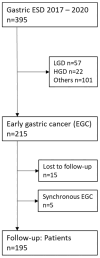Endoscopic Submucosal Dissection for Early Gastric Cancer Exceeding Expanded Criteria-Long-Term Outcomes from the German ESD Registry
- PMID: 39337025
- PMCID: PMC11432303
- DOI: 10.3390/jcm13185538
Endoscopic Submucosal Dissection for Early Gastric Cancer Exceeding Expanded Criteria-Long-Term Outcomes from the German ESD Registry
Abstract
Background and aims: Endoscopic submucosal dissection (ESD) has become a standard treatment for early gastric cancer (EGC), often fulfilling guideline criteria (GC) or expanded criteria (EC). When lesions exceed the EC, surgical resection is recommended. However, a subgroup of these patients are not treated surgically. The aim of this study was to investigate the long-term follow-up of patients after ESD for EGC outside the EC (out of indication; OI). Methods: Patients who were included in the prospective German ESD registry were analyzed when ESD was performed for EGC. Patients were stratified in three groups according to histopathological features (GC, EC and OI). The results were evaluated in terms of patient characteristics, procedure characteristics and follow-up data. Results: Over a 48-month period, 195 patients from 14 German centers were included. In total, 71 lesions (36.4%) met the guideline criteria, 70 lesions (35.9%) corresponded to the expanded criteria and 54 lesions (27.7%) turned out to be OI. The R0 resection rate was significantly higher for the GC and EC groups than for the OI group (94.4% vs. 84.3% vs. 55.6%, p < 0.001). Additional surgery was not performed in 72% (39/54) of patients in the OI group. During a mean follow-up of 37 months, overall survival showed no significant difference between the EC and OI groups when endoscopic follow-up was performed without additional surgery (p = 0.064). Conclusions: The results show that a good long-term survival can be achieved after ESD for patients with OI lesions without additional surgery. The treatment decision has to be made on an individual basis, taking the patient's comorbidities and the risk of surgical resection into account.
Keywords: early gastric cancer; endoscopic resection; endoscopic submucosal dissection; endoscopy; expanded criteria; guideline criteria.
Conflict of interest statement
Messmann: Olympus, Satisfai (grants), Falk Pharma, Olympus, Norgine, IPSEN, medupdate, Erbe (speakers fees), Olympus, Ambu, Boston Scientific, Covidien, Takeda (consultation fees); Rempel: Olympus, Falk (lecture fees, tutoring, consultancy); Steinbrück: Olympus, Falk (lecture fees and travel grants); Allgaier: Olympus, Falk (lecture fees); Dumoulin: Olympus (lecture fees, tutoring, consultancy). The other authors declare no conflicts of interest.
Figures




References
LinkOut - more resources
Full Text Sources
Miscellaneous

